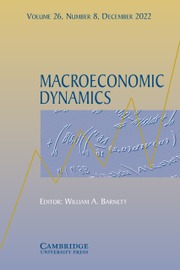No CrossRef data available.
Article contents
Heterogeneous bequests and social inequalities
Published online by Cambridge University Press: 03 February 2025
Abstract
We study a growth model with two types of agents who are heterogeneous in their degree of family altruism. We prove that every equilibrium path of consumption, bequests, and capital converges to a unique steady state and study the effect of altruism on the properties of steady-state equilibrium. We show that aggregate income is positively related to both level of altruism and altruism heterogeneity. When altruism heterogeneity is low or moderate, income inequality follows an inverse U-shaped pattern relative to the level of altruism. These observations are consistent with the cross-country Kuznets curve linking different steady-state levels of income to steady-state levels of inequality. When altruism heterogeneity is high, income inequality decreases with the level of altruism. Our results suggest that heterogeneous altruism is a possible mechanism linking economic growth and income inequality.
Information
- Type
- Articles
- Information
- Copyright
- © The Author(s), 2025. Published by Cambridge University Press

